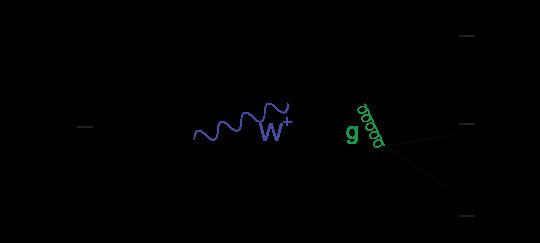 | ||
Mesons are unstable subatomic particles composed of one quark and one antiquark. They are part of the hadron particle family – particles made of quarks. The other members of the hadron family are the baryons – subatomic particles composed of three quarks. The main difference between mesons and baryons is that mesons have integer spin (thus are bosons) while baryons are fermions (half-integer spin). Because mesons are bosons, the Pauli exclusion principle does not apply to them. Because of this, they can act as force mediating particles on short distances, and thus play a part in processes such as the nuclear interaction.
Contents
Since mesons are composed of quarks, they participate in both the weak and strong interactions. Mesons with net electric charge also participate in the electromagnetic interaction. They are classified according to their quark content, total angular momentum, parity, and various other properties such as C-parity and G-parity. While no meson is stable, those of lower mass are nonetheless more stable than the most massive mesons, and are easier to observe and study in particle accelerators or in cosmic ray experiments. They are also typically less massive than baryons, meaning that they are more easily produced in experiments, and will exhibit higher-energy phenomena sooner than baryons would. For example, the charm quark was first seen in the J/Psi meson (
J/ψ
) in 1974, and the bottom quark in the upsilon meson (
ϒ
) in 1977.
Each meson has a corresponding antiparticle (antimeson) where quarks are replaced by their corresponding antiquarks and vice versa. For example, a positive pion (
π+
) is made of one up quark and one down antiquark; and its corresponding antiparticle, the negative pion (
π−
), is made of one up antiquark and one down quark. Some experiments show the evidence of tetraquarks – "exotic" mesons made of two quarks and two antiquarks, but the particle physics community as a whole does not view their existence as likely, although still possible.
The symbols encountered in these lists are: I (isospin), J (total angular momentum), P (parity), C (C-parity), G (G-parity), u (up quark), d (down quark), s (strange quark), c (charm quark), b (bottom quark), Q (charge), B (baryon number), S (strangeness), C (charm), and B′ (bottomness), as well as a wide array of subatomic particles (hover for name).
Summary table
Because this table was initially derived from published results and many of those results were preliminary, as many as 64 of the mesons in the following table may not exist or have the wrong mass or quantum numbers.
Meson properties
The following lists detail all known and predicted pseudoscalar (JP = 0−) and vector (JP = 1−) mesons.
The properties and quark content of the particles are tabulated below; for the corresponding antiparticles, simply change quarks into antiquarks (and vice versa) and flip the sign of Q, B, S, C, and B′. Particles with † next to their names have been predicted by the standard model but not yet observed. Values in red have not been firmly established by experiments, but are predicted by the quark model and are consistent with the measurements.
Pseudoscalar mesons
[a] ^ Makeup inexact due to non-zero quark masses.
[b] ^ PDG reports the resonance width (Γ). Here the conversion τ = ħ⁄Γ is given instead.
[c] ^ Strong eigenstate. No definite lifetime (see kaon notes below)
[d] ^ The mass of the
K0
L and
K0
S are given as that of the
K0
. However, it is known that a difference between the masses of the
K0
L and
K0
S on the order of 6989220000000000000♠2.2×10−11 MeV/c2 exists.
[e] ^ Weak eigenstate. Makeup is missing small CP–violating term (see notes on neutral kaons below).
Vector mesons
[f] ^ PDG reports the resonance width (Γ). Here the conversion τ = ħ⁄Γ is given instead.
[g] ^ The exact value depends on the method used. See the given reference for detail.
Notes on neutral kaons
There are two complications with neutral kaons:
K0
S and
K0
L are not eigenstates of strangeness. However, they are eigenstates of the weak force, which determines how they decay, so these are the particles with definite lifetime.
K0
S and
K0
L are not exactly correct, since there is a small correction due to CP violation. See CP violation in kaons.
Note that these issues also exist in principle for other neutral flavored mesons; however, the weak eigenstates are considered separate particles only for kaons because of their dramatically different lifetimes.
